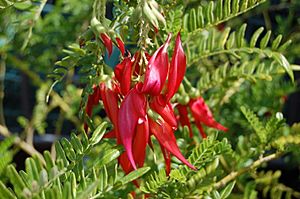Kaka beak facts for kids
Quick facts for kids Kaka beak |
|
|---|---|
 |
|
| Conservation status | |
 Nationally Critical (NZ TCS) |
|
| Scientific classification | |
| Genus: |
Clianthus
|
| Species: |
maximus
|
Clianthus maximus, commonly known as kaka beak (kōwhai ngutu-kākā in Māori), is a special woody plant native to New Zealand's North Island. It is one of two types of Clianthus plants. Both have amazing clusters of red flowers that look like the beak of the kaka, a native New Zealand parrot.
This plant is very rare in the wild. In 2005, only 153 plants were found. This was a big drop from over 1,000 plants in 1996. These wild plants grow in the East Coast and northern Hawkes Bay areas of New Zealand.
Contents
About the Kaka Beak Plant
What Does it Look Like?
The Clianthus maximus is a small, woody plant that can grow from 1.5 to 6 metres tall. It has shiny green leaves. Its dark red flowers usually appear between August and December. These flowers hang down in groups of 15 to 20 blooms. The plant's stems are quite soft and can break easily.
How it Was Discovered
A botanist named William Colenso first described Clianthus maximus in 1885. He realized it was different from the other kaka beak plant, C. puniceus. Later, in 1899, another botanist, Thomas Kirk, thought C. maximus was just a type of C. puniceus. But in 2000, Peter Heenan confirmed that C. maximus is indeed its own separate species.
Growing Kaka Beak Plants
Before the 1990s, Clianthus maximus was not often grown in gardens. Most kaka beak plants sold were C. puniceus. However, now you can easily find C. maximus plants in garden shops across New Zealand. Growing them helps protect this special plant.
Images for kids
See also
 In Spanish: Clianthus para niños
In Spanish: Clianthus para niños



